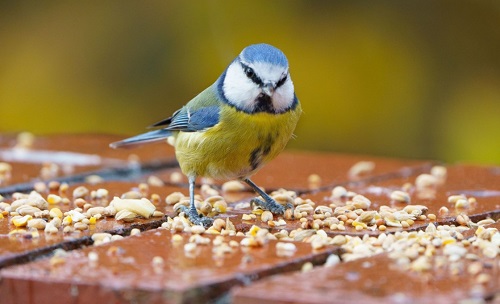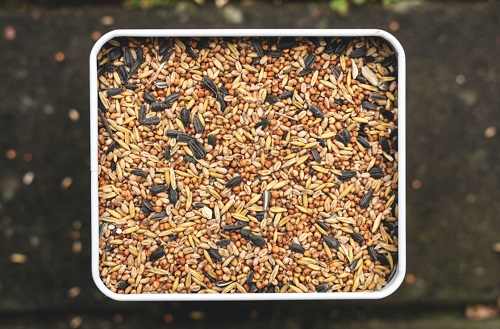Making bird food at home is a rewarding activity that offers a chance to support local bird populations while ensuring that they receive the nutrients they need. Whether you’re a seasoned bird watcher or just starting out, creating your own bird food allows you to control the ingredients, offering a healthier alternative to commercial bird food. This guide will walk you through the best ingredients to use, how to prepare various bird food recipes, and tips for storing your homemade creations to keep them fresh. Let’s dive into the essentials of how to make bird food at home and attract a variety of birds to your backyard.

What Ingredients Are Best for Homemade Bird Food?
Choosing Seeds and Grains
The foundation of any good bird food mix is seeds and grains, which provide the essential nutrients that many birds need. Sunflower seeds are a popular choice, as they are high in fat and attract a wide variety of birds, from finches to cardinals. Millet is another staple, particularly favored by smaller birds like sparrows and juncos. Cracked corn is inexpensive and provides a good source of energy, especially for larger birds. When selecting seeds and grains, it’s important to consider the types of birds you want to attract. Mixing these ingredients in the right proportions will help ensure that your bird food is well-balanced and appealing to a diverse range of birds.
Adding Fruits and Nuts
Fruits and nuts are excellent additions to homemade bird food, providing additional vitamins, minerals, and natural sugars that are especially beneficial during the colder months. Dried fruits like raisins, cranberries, and apricots can be mixed into seed blends or offered separately to attract species that enjoy sweet treats. Nuts, particularly unsalted peanuts and almonds, offer a rich source of fats and proteins. These can be chopped and added to your bird food mix or used to create specialized blends that cater to certain species. Including a variety of fruits and nuts in your bird food will not only enhance its nutritional value but also make it more appealing to a broader range of bird species.
Including Suet and Fats
Suet and fats are vital components of bird food, especially in winter when birds need extra energy to stay warm. Suet, which is hard fat from around the kidneys of cattle and sheep, can be purchased or made at home and is often combined with other ingredients like seeds, grains, and dried fruits to create high-energy cakes. Peanut butter is another popular fat source that can be easily incorporated into homemade bird food. When using fats, it’s important to ensure they are unsalted and free from preservatives, as these can be harmful to birds. Including these rich fat sources in your bird food will provide the energy boost birds need, particularly in colder weather.

How Do You Prepare Bird Food at Home?
Simple Seed Mix Recipe
Creating a simple seed mix at home is a straightforward process that can be tailored to the birds in your area. Start with a base of black oil sunflower seeds, which are high in fat and a favorite among many bird species. Add white millet and cracked corn in equal parts to balance the mix. For an added nutritional boost, consider adding a handful of safflower seeds, which are rich in protein and fat. Mix these ingredients thoroughly and store them in an airtight container until you’re ready to use them. This basic recipe can be adjusted depending on the birds you want to attract and the season, ensuring a versatile and effective bird food mix.
Homemade Suet Cake Recipe
Making suet cakes at home is a simple and cost-effective way to provide birds with the high-energy food they need. Start by melting one part suet or lard in a pan over low heat. Once melted, mix in two parts of a dry ingredient blend, such as birdseed, oats, cornmeal, and dried fruits. Stir the mixture until all the ingredients are well coated. Pour the mixture into molds or a shallow dish lined with parchment paper, then refrigerate until solid. Once the suet cakes are firm, they can be cut into blocks and placed in a suet feeder. These homemade suet cakes are ideal for providing essential fats and nutrients to birds during cold weather.
Creating a Fruit and Nut Blend
To make a fruit and nut blend, start by selecting a mix of dried fruits and unsalted nuts. Good choices include raisins, dried cranberries, chopped apricots, and unsalted peanuts or almonds. Chop the larger fruits and nuts into smaller pieces to make them more manageable for birds. Combine these with a base of sunflower seeds or a pre-mixed bird seed blend. Stir the mixture thoroughly to ensure an even distribution of fruits and nuts. This blend can be served on its own in a tray feeder or mixed with other seed blends to create a diverse and nutrient-rich option that will attract a variety of birds.
How to Store Homemade Bird Food for Freshness?
Proper storage is key to maintaining the freshness and nutritional value of your homemade bird food. Begin by storing your bird food in airtight containers to prevent moisture from getting in, which can cause mold and spoilage. Keep these containers in a cool, dry place, such as a pantry or a garage, away from direct sunlight and pests. For larger batches, consider using vacuum-sealed bags, which can extend the shelf life of your bird food. It’s also a good idea to store different types of bird food separately, particularly those containing fats or dried fruits, to prevent cross-contamination and to maintain freshness.
Tips for Attracting Specific Birds with Homemade Food
Attracting specific birds to your yard can be achieved by tailoring your bird food recipes to their preferences. For instance, if you want to attract finches, include more nyjer seeds in your mix, as they are a favorite of these small birds. Woodpeckers and nuthatches are particularly drawn to suet, so placing homemade suet cakes in your yard can increase the likelihood of these birds visiting. If you’re hoping to attract hummingbirds, consider placing a feeder filled with homemade sugar water nearby. The key to attracting specific birds is understanding their dietary preferences and adjusting your recipes and feeding methods accordingly.
Conclusion
Making bird food at home is a simple and enjoyable way to support your local bird population while ensuring that they receive the best possible nutrition. By choosing the right ingredients, preparing balanced recipes, and storing your bird food properly, you can create a backyard haven for a variety of bird species. Not only does learning how to make bird food allow you to control what goes into the mix, but it also offers the satisfaction of knowing you’re providing a healthy and natural food source for your feathered friends. So, gather your ingredients, follow these recipes, and enjoy the beauty of birds flocking to your homemade creations.
FAQ:
1.What are the benefits of making bird food at home?
Making bird food at home ensures you know exactly what’s going into the mix, providing a healthier and often more cost-effective option for feeding birds. It also allows you to customize the food to attract specific birds.
2.Can I use kitchen scraps to make bird food?
Yes, but caution is needed. While some kitchen scraps like unsalted nuts and certain fruits can be great for birds, avoid giving them processed foods, salted items, or foods that may spoil quickly, which can be harmful.
3.How often should I refill my bird feeder with homemade food?
Refilling frequency depends on bird activity, but generally, it’s best to refill when the feeder is about half empty. This keeps the food fresh and ensures a steady supply for your visiting birds.
